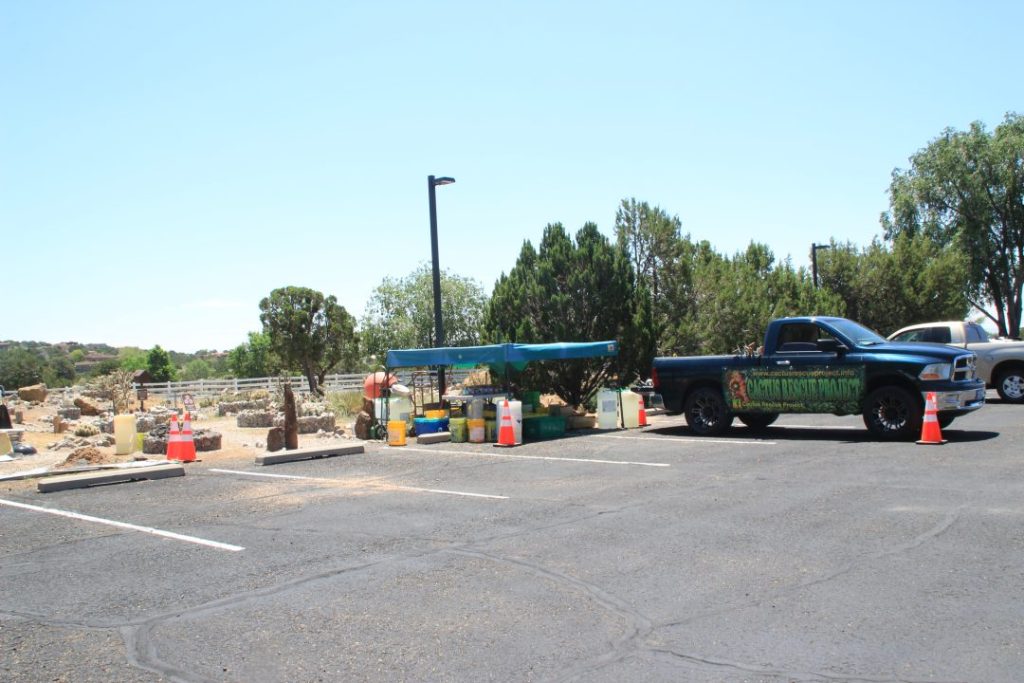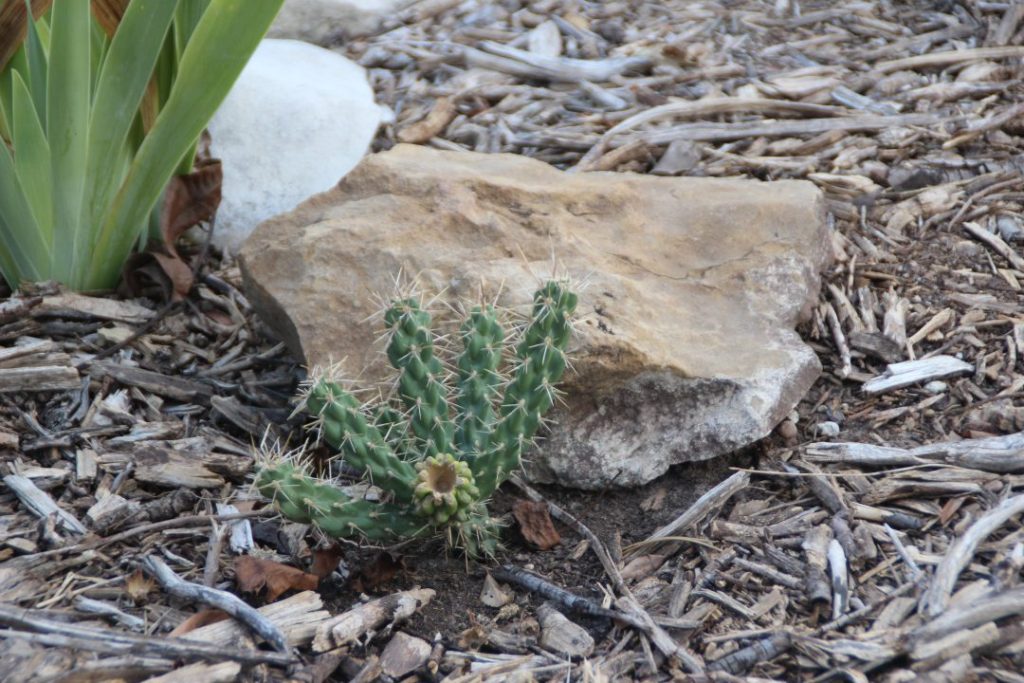I toured the El Dorado Cactus Rescue project while in Santa Fe for the Mid States Cactus and Succulent Conference. I found it to be quite a worthwhile and ambitious project, I must say!
The rescue project started in 2002 when cactus aficionados John “Obie” Oberhausen and Joe Newman saw the need to rescue the Santa Fe cholla, Cylindropuntia viridiflora, which was in need of protection since it was only found in limited quantities in a few locations in the Santa Fe area. Most were growing in prime real estate sites which would eventually be developed at the expense of the cholla’a habitat.
Obie and Joe began collecting cuttings of the cactus to start new plants, even tearing up pack rats’ nests for pieces of the cholla used to build their nests! Gradually, as the cuttings developed into larger plants, they continued to root cuttings and share plants, making others aware of this endangered species. They would visit nurseries and talk with customers about conservation of the cholla and other cactus concerns to the point that people started asking what organization they were with and did they have a business card. So, by 2003 Obie and Joe decided they were the Cactus Rescue Project, which made it official. Along with their efforts to educate the public, they decided to plant a garden for some of these plants at the El Dorado Community Improvement Association site.
Joe is a retired industrial engineer; Obie served in the Navy and on retirement became a massage therapist. Neither one claimed to be a cactus expert; they simply shared a passion for the plants and a desire to protect them. So when that first garden was started, Joe was said to be the artist, the architect of the garden, and Obie saw to it that he and others supplied the labor involved to get the job done.
That garden is referred to as the first garden because they are now hard at work on the second garden. And, they have enlarged their efforts by promoting cactus and other drought-tolerant plants for xeriscape-style gardens in arid, drought-affected areas and have planted several public gardens in the area to demonstrate how that landscape can work.
Cylindropuntia viridiflora, Santa Fe cholla, is a smaller, bushier cholla not to be confused with the more common tree cholla, Cylindropuntia imbricata, found in Texas and other southwestern states. Its other distinguishing characteristic is the bronze orange to salmon pink flower it produces in late spring to early summer, totally different to the purple flower on the tree cholla.
Photo courtesy of El Dorado Cactus Rescue Project
As I drove into the El Dorado Community Improvement Association, I saw and parked by a work in progress, what I was to later learn is the second garden.
As I walked around this area, I saw many of these round beds planted with cactus. I was told that gophers were a problem eating the roots of the plants and the pack rats would nibble on lower branches, gather pieces for their nests, and make a mess. So this second garden has been planted with gabions, those cages made of wire filled with rocks and lined on the bottom with wire netting to keep the gophers away from the roots and the plants being higher off the ground, to get the lower branches up higher and away from the rats.
But other styles of planting the cactus were used as well.
I was met as I walked around by Catherine Williamson, one of the core volunteers in charge of the garden, and she told me this was indeed the second garden, that the first garden I had not seen yet.. So we walked over to see that garden, which was considerably more advanced than this unfinished one.
As I mentioned earlier, in the beginning, Obie and Joe rooted lots of cuttings of Santa Fe cholla and gave them away in an effort to increase the number of plants that would be planted in safe places in people’s yards and gardens, which was one way of making sure the cholla would not fade away.Then they realized that the thing to do was plant their own garden as a safe place for this cactus. So the work began. Posters with pictures are displayed showing the progress of the garden. This is what it looked like in 2013
This is the garden today. Needless to say, it has come a long way. Sixty-one species of cholla, other cactus, agaves, yucca, and other drought-tolerant plants have a home here and are cared for and enjoyed by the many volunteers who help keep it in good form.
The cholla in the center of the picture below is a Santa Fe cholla. Notice how it is smaller and bushier than the tree cholla. If you look closely, you can see the tops of the fruit, sort of yellow, that are left from this year’s blooms. Obie passed away after a battle with cancer in 2022. But because he was one of the two who started this whole cactus rescue thing, in his honor the Santa Fe cactus is unofficially referred to now as the Obie cholla. A plaque commemorating his twenty years of loyal service to the project stands at the entrance to the garden in an earlier picture.
Four of the ten managing core group volunteers were on hand the day I toured: Nancy Lehrhaupt, C.J. Sanchez, Catherine Williamson, and Joe Newman. The core group is in charge of the planning and organizing for the Cactus Rescue Project (CRP). Nancy told me they have a list of about 500 emails of people willing to volunteer their time to work in the gardens. When help is needed for weeding, planting, pruning, whatever is called for, a blanket emailing goes out and anywhere from fifteen to fifty people magically appear to help. CRP has planted about ten public gardens in the Santa Fe area, and when those gardens need to be pruned, volunteers come to help with that, too, and then help give away those cuttings. They have given away rooted cuttings for the last eight to ten years and have had anywhere from one hundred to two hundred people show up for the give away, which is a fun outing and a way to help increase the Santa Fe cholla population.
The El Dorado Community Improvement Association isn’t hard to find in El Dorado, just a few miles south of Santa Fe on Hwy 285, Stop for a visit, learn about the Santa Fe cholla, and if you go in July, you might go home with a rooted cutting to add to your garden.
I scored this rooted cutting, by the way, because I had attended the Mid States Conference, and we had been invited to tour the garden. Those of us who took the tour were lucky enough to receive a cutting. The actual give-away of those cuttings occurs toward the end of July, so if you are interested, you might want to check the Cactus Rescue Project Facebook page to find out when to visit. Nancy also said the best time to see everything in bloom is May and June
It’s worth the trip, cutting or not.
Thanks to Nancy Lehrhaupt and Catherine Williamson for their help with this story.
To see more pictures and read about the Cactus Rescue Project and their other gardening projects, visit the links below.
https://www.facebook.com/search/top?q=cactus%20rescue%20project
https://sites.google.com/site/cactusrescueproject/the-beginnings
https://rewilding.org/introducing-the-santa-fe-based-cactus-rescue-project/












Recent Comments